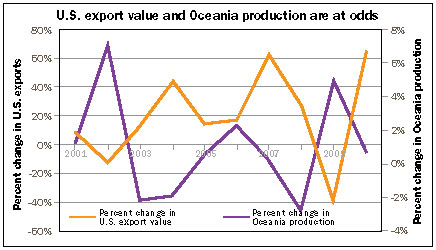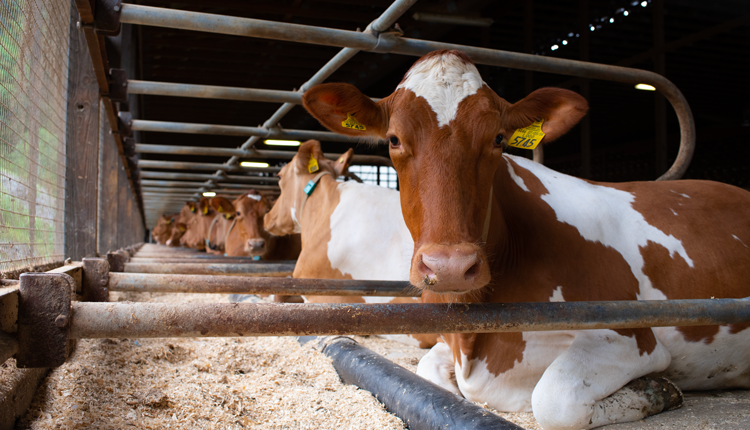The author is director of Dairy Policy Analysis, University of Wisconsin-Madison.
Every year, about this time, I spend extra effort developing my outlook for dairy. Every year a story unfolds about why milk prices are expected to move up or down, and the story usually derives from a different set of circumstances than the previous year. This year the drought would be that story - the main character. But this year is somewhat different; I'm not as much interested in the story as I am the backstory.
A backstory tells us about what made the character in the first place. The drought covers a big portion of the U.S. but the largest dairy regions of the country were not particularly hard hit. The eastern third of the country basically had no drought impacts; California, Wisconsin, Idaho and other major dairy states had some impact from the drought; but nothing like Indiana, Illinois, Nebraska, Kansas and South Dakota. So, what makes the dairy sector so vulnerable to the drought . . . that's the backstory.
Feed prices are the backstory
Of course the answer is high feed prices. But decades ago, milk production in the dairy states would have suffered little impact by drought in other parts of the country. "Traditional" dairy farms would have grown most all of their feeds and produced about similar levels of milk. Today, most intensively managed dairy farms purchase a large portion (if not all) of their feeds and are more vulnerable to the short-term impacts of rising feed prices.
In order for modern dairy farms to capture the genetic potential of our cows, we feed them a substantial amount of starch in the form of a high-concentrate diet. Last year the U.S. averaged more than 21,000 pounds per cow. Our highest-yielding state, New Mexico, had nearly a 25,000 pound average. And the nation's highest-producing cow passed the 70,000-pound barrier.
There is no doubt we can make a lot of milk per cow, but it comes at a cost. No other major milk producing country comes close to our productivity. Canada is approaching 17,000 pounds per cow. Our major competitors for world markets like the EU averages about 13,000 to 14,000 pounds per cow, and Australia and New Zealand, with a pasture based system, average less than half of our yields.
Competition for exports
A by-product of competing for the same export markets is that our farm gate milk prices have converged with world prices. In some years, the U.S. milk price may be a bit higher than New Zealand's but not always - essentially, the prices are basically moving together. And our total costs of production are also about the same. However, our cost structure is very different.
High-concentrate feeding and our intensive dairy production have given us high variable costs but relatively low fixed costs. New Zealand has relatively low variable costs of production along with lower yields, but they have bid up the price of pasture land to the point that they have quite high fixed costs in land investment.
There is no right or wrong to these different business models, but there are consequences. A New Zealand dairy farmer does not like low milk prices any better than a California or a Wisconsin dairy producer. But a New Zealand dairy farmer does not face price risk. Instead, he or she faces production risk and is at the mercy of the weather. Their production decision is simple - make as much milk as you can from the quality of the pasture. U.S. farms face price risk and are vulnerable to periods of low prices or high input costs.
Let me illustrate. A somewhat typical New Zealand dairy farm may have $7 per hundredweight (cwt.) of variable costs and $12 of fixed costs. They need more than $19 milk to breakeven. Meanwhile, a U.S. farm may have $12 of variable costs and $7 of fixed costs also needing $19 to breakeven.
If the price falls to $16, both farms are losing $3 per cwt. that year but neither one is likely to change their production decision. If the price falls to $10, both farms will lose $9 per cwt. on all milk. But what if they didn't produce milk? They wouldn't have to pay their variable costs but they are still liable for their fixed costs of production. Now the New Zealand farm loses $12 and the U.S. farm only loses $7. The U.S. farm loses less by not producing milk but the New Zealand farm will still produce milk due to higher fixed costs.

So here is the backstory: U.S. dairy producers have embraced a business model that makes them incredibly agile and able to boost milk production in a very short period of time. The downside is that we are also more vulnerable to our variable costs of production. We are balancing both U.S. and world markets, and our growth opportunities are dictated when either Oceania has weather problems or the world demand for dairy products grow. The chart shows the inverse relationship between the value of our exports and Oceania's production.
The bottom line
New Zealand and Australia have had very good rains and have started their production year with pastures in great shape. They expect to have a fairly large gain in milk production. That would normally mean that we would be expecting low milk prices as exports soften for U.S. products. But this year the U.S. drought has raised our variable costs of production and our milk supply is contracting in response to those higher costs. We simply won't have as much to export as we would have under normal conditions. The result is that we have turned what would have been a bad milk price year into a bad feed cost year.
On the revenue side, futures markets are showing corn prices holding in the $7.50 per bushel range until we get closer to next harvest season. In contrast, soybean meal futures do show a decline of nearly $100 per ton over the course of the next year so feed prices will moderate somewhat.
On the revenue side, futures markets are also showing declining milk prices over the next year into the $18 to $19 range for Class III. Here is where I will disagree with the markets. I think that our milk production will tighten enough from squeezed margins through the fourth quarter of 2013 to support higher milk prices; higher than the futures market is currently offering. Look for margins to diminish in the short term but improve through the first half of 2013.
Every year, about this time, I spend extra effort developing my outlook for dairy. Every year a story unfolds about why milk prices are expected to move up or down, and the story usually derives from a different set of circumstances than the previous year. This year the drought would be that story - the main character. But this year is somewhat different; I'm not as much interested in the story as I am the backstory.
A backstory tells us about what made the character in the first place. The drought covers a big portion of the U.S. but the largest dairy regions of the country were not particularly hard hit. The eastern third of the country basically had no drought impacts; California, Wisconsin, Idaho and other major dairy states had some impact from the drought; but nothing like Indiana, Illinois, Nebraska, Kansas and South Dakota. So, what makes the dairy sector so vulnerable to the drought . . . that's the backstory.
Feed prices are the backstory
Of course the answer is high feed prices. But decades ago, milk production in the dairy states would have suffered little impact by drought in other parts of the country. "Traditional" dairy farms would have grown most all of their feeds and produced about similar levels of milk. Today, most intensively managed dairy farms purchase a large portion (if not all) of their feeds and are more vulnerable to the short-term impacts of rising feed prices.
In order for modern dairy farms to capture the genetic potential of our cows, we feed them a substantial amount of starch in the form of a high-concentrate diet. Last year the U.S. averaged more than 21,000 pounds per cow. Our highest-yielding state, New Mexico, had nearly a 25,000 pound average. And the nation's highest-producing cow passed the 70,000-pound barrier.
There is no doubt we can make a lot of milk per cow, but it comes at a cost. No other major milk producing country comes close to our productivity. Canada is approaching 17,000 pounds per cow. Our major competitors for world markets like the EU averages about 13,000 to 14,000 pounds per cow, and Australia and New Zealand, with a pasture based system, average less than half of our yields.
Competition for exports
A by-product of competing for the same export markets is that our farm gate milk prices have converged with world prices. In some years, the U.S. milk price may be a bit higher than New Zealand's but not always - essentially, the prices are basically moving together. And our total costs of production are also about the same. However, our cost structure is very different.
High-concentrate feeding and our intensive dairy production have given us high variable costs but relatively low fixed costs. New Zealand has relatively low variable costs of production along with lower yields, but they have bid up the price of pasture land to the point that they have quite high fixed costs in land investment.
There is no right or wrong to these different business models, but there are consequences. A New Zealand dairy farmer does not like low milk prices any better than a California or a Wisconsin dairy producer. But a New Zealand dairy farmer does not face price risk. Instead, he or she faces production risk and is at the mercy of the weather. Their production decision is simple - make as much milk as you can from the quality of the pasture. U.S. farms face price risk and are vulnerable to periods of low prices or high input costs.
Let me illustrate. A somewhat typical New Zealand dairy farm may have $7 per hundredweight (cwt.) of variable costs and $12 of fixed costs. They need more than $19 milk to breakeven. Meanwhile, a U.S. farm may have $12 of variable costs and $7 of fixed costs also needing $19 to breakeven.
If the price falls to $16, both farms are losing $3 per cwt. that year but neither one is likely to change their production decision. If the price falls to $10, both farms will lose $9 per cwt. on all milk. But what if they didn't produce milk? They wouldn't have to pay their variable costs but they are still liable for their fixed costs of production. Now the New Zealand farm loses $12 and the U.S. farm only loses $7. The U.S. farm loses less by not producing milk but the New Zealand farm will still produce milk due to higher fixed costs.

So here is the backstory: U.S. dairy producers have embraced a business model that makes them incredibly agile and able to boost milk production in a very short period of time. The downside is that we are also more vulnerable to our variable costs of production. We are balancing both U.S. and world markets, and our growth opportunities are dictated when either Oceania has weather problems or the world demand for dairy products grow. The chart shows the inverse relationship between the value of our exports and Oceania's production.
The bottom line
New Zealand and Australia have had very good rains and have started their production year with pastures in great shape. They expect to have a fairly large gain in milk production. That would normally mean that we would be expecting low milk prices as exports soften for U.S. products. But this year the U.S. drought has raised our variable costs of production and our milk supply is contracting in response to those higher costs. We simply won't have as much to export as we would have under normal conditions. The result is that we have turned what would have been a bad milk price year into a bad feed cost year.
On the revenue side, futures markets are showing corn prices holding in the $7.50 per bushel range until we get closer to next harvest season. In contrast, soybean meal futures do show a decline of nearly $100 per ton over the course of the next year so feed prices will moderate somewhat.
On the revenue side, futures markets are also showing declining milk prices over the next year into the $18 to $19 range for Class III. Here is where I will disagree with the markets. I think that our milk production will tighten enough from squeezed margins through the fourth quarter of 2013 to support higher milk prices; higher than the futures market is currently offering. Look for margins to diminish in the short term but improve through the first half of 2013.
This article appears on page 816 of the December issue of Hoard's Dairyman.










